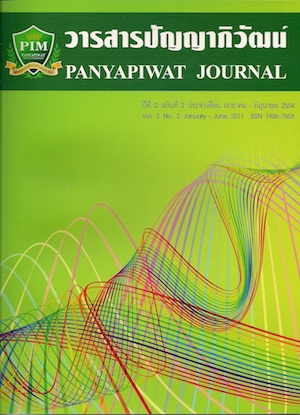ระบบรหัสลับที่เพิ่มความปลอดภัยให้กับข้อมูล
Main Article Content
บทคัดย่อ
บทคัดย่อ
บทความฉบับนี้มีวัตถุประสงค์เพื่อนำเสนอวิวัฒนาการของการเข้ารหัสลับ โดยเริ่มต้นจากวิธีการเข้ารหัสแบบซีซาร์ ซึ่งการเข้ารหัสนี้ถูกตั้งชื่อตามจูเลียส ซีซาร์ ผู้ที่นำวิธีการเข้ารหัสลับมาใช้ในการติดต่อกับเหล่าแม่ทัพในยามศึกสงคราม ต่อมาได้มีการพัฒนาวิธีการเข้ารหัสลับแบบต่าง ๆ เพื่อให้การสื่อสารข้อมูลมีความปลอดภัยมากขึ้น จนกระทั่งในปัจจุบันวิธีการเข้ารหัสลับข้อมูลที่ได้รับนิยมเป็นอย่างมากมีอยู่ 2 วิธี ได้แก่ 1. การเข้ารหัสแบบกุญแจลับ 2. การเข้ารหัสลับแบบกุญแจสาธารณะ ในบทความฉบับนี้ได้เปรียบเทียบข้อดีและข้อเสียของวิธีการเข้ารหัสลับทั้ง 2 แบบ พร้อมทั้งแสดงวิธีการนำการเข้ารหัสลับแบบกุญแจสาธารณะด้วยวิธี RSA ไปใช้ประโยชน์ในเรื่องของความต้องการความเป็นส่วนตัวและการยืนยันตัวบุคคล สำหรับส่วนสุดท้ายของบทความฉบับนี้ได้กล่าวถึงปัจจัยที่มีผลต่อความปลอดภัยของวิธีการเข้ารหัสลับแบบกุญแจสาธารณะด้วยวิธี RSA
คำสำคัญ : การเข้ารหัสลับแบบกุญแจสาธารณะ, การเข้ารหัสแบบกุญแจลับ, RSA
Abstract
This article presents the evolution of cryptography since the initiation of Caesar cipher, the encryption technique named after Julius Caesar who had invented encryption to communicate with his generals during wartime. Later several methods have been developed to improve the communication security. Recently the secret key encryption and the public key encryption have become the most popular encryption techniques. The advantages and disadvantages of these two techniques have been discussed in this article. We also show how RSA, the most famous of the public key cryptosystem, provides cryptographic privacy and authentication for data communication. Finally, the security issues related to RSA encryption have been discussed.
Keywords : Public key cryptography, Secret key cryptography, RSA
Article Details
“ข้าพเจ้าและผู้เขียนร่วม (ถ้ามี) ขอรับรองว่า บทความที่เสนอมานี้ยังไม่เคยได้รับการตีพิมพ์และไม่ได้อยู่ระหว่างกระบวนการพิจารณาลงตีพิมพ์ในวารสารหรือแหล่งเผยแพร่อื่นใด ข้าพเจ้าและผู้เขียนร่วมยอมรับหลักเกณฑ์การพิจารณาต้นฉบับ ทั้งยินยอมให้กองบรรณาธิการมีสิทธิ์พิจารณาและตรวจแก้ต้นฉบับได้ตามที่เห็นสมควร พร้อมนี้ขอมอบลิขสิทธิ์บทความที่ได้รับการตีพิมพ์ให้แก่สถาบันการจัดการปัญญาภิวัฒน์หากมีการฟ้องร้องเรื่องการละเมิดลิขสิทธิ์เกี่ยวกับภาพ กราฟ ข้อความส่วนใดส่วนหนึ่งและ/หรือข้อคิดเห็นที่ปรากฏในบทความข้าพเจ้าและผู้เขียนร่วมยินยอมรับผิดชอบแต่เพียงฝ่ายเดียว”
เอกสารอ้างอิง
Atkins, D., Snyder, J., Hare, C. (1997). Internet Security Professional Reference 2nd edition.Indianapolis: New Riders Publishing.
Buchmann, J.A. (2004). Introduction to crypto-graphy. New York: Springer.
Coutinho, S.C. (1999). The Mathematics of Ciphers: Number Theory and RSA Crypto-graphy. Massachusetts: A K Peters Press.
Denning, D.E. (1982). Cryptography and data security. Massachusetts: Addison-Wesley Publishing.
DI Management Services Pty Limited. (2011). RSA Algorithm. Retrieved January 15, 2011, from RSA Algorithm Website: http://www.di-gt.com.au/rsa_alg.html
Feisthammel, P. (2004). PGP - Pretty Good Privacy. Retrieved January 15, 2011, from PGP/GnuPGP/OpenPGP - Pretty Good Privacy Website: http://www.rubin.ch/pgp/pgp.en.html
Henk, C. A. (2000). Fundamentals of Cryptology. Boston: Kluwer Academic Publishers.
Janeba, M. (1994). Factoring Challenge Conquered - With a Little Help From Willamette. Retrieved January 15, 2011, from RSA-129 article Website: http://www.willamette.edu/~mjaneba/rsa129.html
Mao, W. (2004). Modern Cryptography, Theory & Practice. New Jersey: Prentice Hall.
Mel, H. X., Baker, D. (2001). Cryptography decrypted. Boston: Addison-Wesley.


